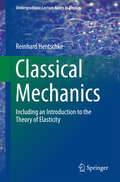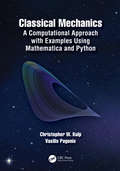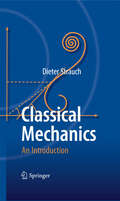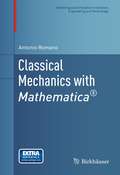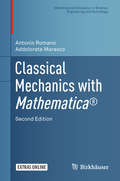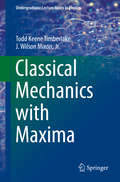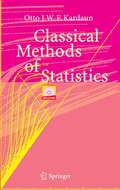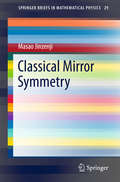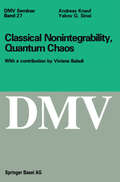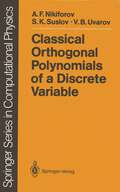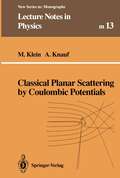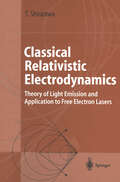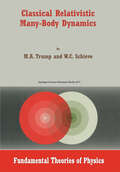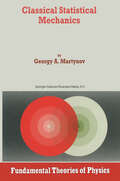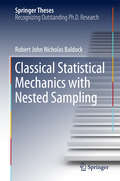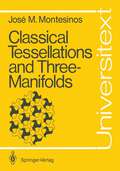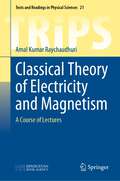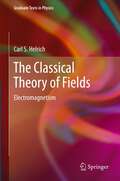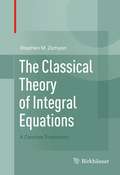- Table View
- List View
Classical Mechanics: Including an Introduction to the Theory of Elasticity (Undergraduate Lecture Notes in Physics)
by Reinhard HentschkeThis textbook teaches classical mechanics as one of the foundations of physics. It describes the mechanical stability and motion in physical systems ranging from the molecular to the galactic scale. Aside from the standard topics of mechanics in the physics curriculum, this book includes an introduction to the theory of elasticity and its use in selected modern engineering applications, e.g. dynamic mechanical analysis of viscoelastic materials. The text also covers many aspects of numerical mechanics, ranging from the solution of ordinary differential equations, including molecular dynamics simulation of many particle systems, to the finite element method. Attendant Mathematica programs or parts thereof are provided in conjunction with selected examples. Numerous links allow the reader to connect to related subjects and research topics. Among others this includes statistical mechanics (separate chapter), quantum mechanics, space flight, galactic dynamics, friction, and vibration spectroscopy. An introductory chapter compiles all essential mathematical tools, ranging from coordinates to complex numbers. Completely solved problems and examples facilitate a thorough understanding of the material.
Classical Mechanics: A Computational Approach with Examples Using Mathematica and Python
by Christopher W. Kulp Vasilis PagonisClassical Mechanics: A Computational Approach with Examples using Python and Mathematica provides a unique, contemporary introduction to classical mechanics, with a focus on computational methods. In addition to providing clear and thorough coverage of key topics, this textbook includes integrated instructions and treatments of computation. Full of pedagogy, it contains both analytical and computational example problems within the body of each chapter. The example problems teach readers both analytical methods and how to use computer algebra systems and computer programming to solve problems in classical mechanics. End-of-chapter problems allow students to hone their skills in problem solving with and without the use of a computer. The methods presented in this book can then be used by students when solving problems in other fields both within and outside of physics. It is an ideal textbook for undergraduate students in physics, mathematics, and engineering studying classical mechanics. Features: Gives readers the "big picture" of classical mechanics and the importance of computation in the solution of problems in physics Numerous example problems using both analytical and computational methods, as well as explanations as to how and why specific techniques were used Online resources containing specific example codes to help students learn computational methods and write their own algorithms A solutions manual is available via the Routledge Instructor Hub and extra code is available via the Support Material tab
Classical Mechanics: A Computational Approach with Examples Using Mathematica and Python
by Christopher W. Kulp Vasilis PagonisClassical Mechanics: A Computational Approach with Examples using Python and Mathematica provides a unique, contemporary introduction to classical mechanics, with a focus on computational methods. In addition to providing clear and thorough coverage of key topics, this textbook includes integrated instructions and treatments of computation. Full of pedagogy, it contains both analytical and computational example problems within the body of each chapter. The example problems teach readers both analytical methods and how to use computer algebra systems and computer programming to solve problems in classical mechanics. End-of-chapter problems allow students to hone their skills in problem solving with and without the use of a computer. The methods presented in this book can then be used by students when solving problems in other fields both within and outside of physics. It is an ideal textbook for undergraduate students in physics, mathematics, and engineering studying classical mechanics. Features: Gives readers the "big picture" of classical mechanics and the importance of computation in the solution of problems in physics Numerous example problems using both analytical and computational methods, as well as explanations as to how and why specific techniques were used Online resources containing specific example codes to help students learn computational methods and write their own algorithms A solutions manual is available via the Routledge Instructor Hub and extra code is available via the Support Material tab
Classical Mechanics: An Introduction
by Dieter StrauchThis upper-level undergraduate and beginning graduate textbook primarily covers the theory and application of Newtonian and Lagrangian, but also of Hamiltonian mechanics. In addition, included are elements of continuum mechanics and the accompanying classical field theory, wherein four-vector notation is introduced without explicit reference to special relativity. The author's writing style attempts to ease students through the primary and secondary results, thus building a solid foundation for understanding applications. Numerous examples illustrate the material and often present alternative approaches to the final results.
Classical Mechanics in Geophysical Fluid Dynamics
by Osamu MoritaThis textbook for senior undergraduate and graduate students outlines and provides links between classical mechanics and geophysical fluid dynamics. It is particularly suitable for the mechanics and fluids dynamics courses of geophysics, meteorology, or oceanography students as well as serving as a general textbook for a course on geophysical fluid dynamics. It describes the motions of rigid bodies and shows how classical mechanics has important applications to geophysics, as in the precession of the earth, oceanic tide, and the retreat of the moon from the earth owing to the tidal friction. Unlike the more general mechanics textbooks this gives a unique presentation of these applications
Classical Mechanics in Geophysical Fluid Dynamics
by Osamu MoritaThis textbook for senior undergraduate and graduate students outlines and provides links between classical mechanics and geophysical fluid dynamics. It is particularly suitable for the mechanics and fluids dynamics courses of geophysics, meteorology, or oceanography students as well as serving as a general textbook for a course on geophysical fluid dynamics. It describes the motions of rigid bodies and shows how classical mechanics has important applications to geophysics, as in the precession of the earth, oceanic tide, and the retreat of the moon from the earth owing to the tidal friction. Unlike the more general mechanics textbooks this gives a unique presentation of these applications
Classical Mechanics in Geophysical Fluid Dynamics
by Osamu MoritaThis new edition of Classical Mechanics in Geophysical Fluid Dynamics describes the motions of rigid bodies and shows how classical mechanics has important applications to geophysics, as in the precessions of the earth, oceanic tides, and the retreat of the moon from the earth owing to the tidal friction. Unlike the more general mechanics textbooks this gives a unique presentation of these applications. The coverage of geophysical fluid dynamics has been revised, with a new chapter on various kinds of gravity waves, a new section on geostrophic turbulence, and new material on the Euler angles, the precession and nutation of a Lagrange top, Rayleigh–Bénard convection, and the Ekman flow. This textbook for senior undergraduate and graduate students outlines and provides links between classical mechanics and geophysical fluid dynamics. It is particularly suitable for geophysics, meteorology, and oceanography students on mechanics and fluid dynamics courses, as well as serving as a general textbook for a course on geophysical fluid dynamics.
Classical Mechanics in Geophysical Fluid Dynamics
by Osamu MoritaThis new edition of Classical Mechanics in Geophysical Fluid Dynamics describes the motions of rigid bodies and shows how classical mechanics has important applications to geophysics, as in the precessions of the earth, oceanic tides, and the retreat of the moon from the earth owing to the tidal friction. Unlike the more general mechanics textbooks this gives a unique presentation of these applications. The coverage of geophysical fluid dynamics has been revised, with a new chapter on various kinds of gravity waves, a new section on geostrophic turbulence, and new material on the Euler angles, the precession and nutation of a Lagrange top, Rayleigh–Bénard convection, and the Ekman flow. This textbook for senior undergraduate and graduate students outlines and provides links between classical mechanics and geophysical fluid dynamics. It is particularly suitable for geophysics, meteorology, and oceanography students on mechanics and fluid dynamics courses, as well as serving as a general textbook for a course on geophysical fluid dynamics.
Classical Mechanics with Mathematica® (Modeling and Simulation in Science, Engineering and Technology)
by Antonio RomanoThis textbook takes a broad yet thorough approach to mechanics, aimed at bridging the gap between classical analytic and modern differential geometric approaches to the subject. Developed by the author from 35 years of teaching experience, the presentation is designed to give students an overview of the many different models used through the history of the field—from Newton to Lagrange—while also painting a clear picture of the most modern developments. Throughout, it makes heavy use of the powerful tools offered by Mathematica. The volume is organized into two parts. The first focuses on developing the mathematical framework of linear algebra and differential geometry necessary for the remainder of the book. Topics covered include tensor algebra, Euclidean and symplectic vector spaces, differential manifolds, and absolute differential calculus. The second part of the book applies these topics to kinematics, rigid body dynamics, Lagrangian and Hamiltonian dynamics, Hamilton–Jacobi theory, completely integrable systems, statistical mechanics of equilibrium, and impulsive dynamics, among others.Unique in its scope of coverage and method of approach, Classical Mechanics will be a very useful resource for graduate students and advanced undergraduates in applied mathematics and physics who hope to gain a deeper understanding of mechanics.
Classical Mechanics with Mathematica® (Modeling and Simulation in Science, Engineering and Technology)
by Antonio Romano Addolorata MarascoThis textbook takes a broad yet thorough approach to mechanics, aimed at bridging the gap between classical analytic and modern differential geometric approaches to the subject. Developed by the authors from over 30 years of teaching experience, the presentation is designed to give students an overview of the many different models used through the history of the field—from Newton to Hamilton—while also painting a clear picture of the most modern developments. The text is organized into two parts. The first focuses on developing the mathematical framework of linear algebra and differential geometry necessary for the remainder of the book. Topics covered include tensor algebra, Euclidean and symplectic vector spaces, differential manifolds, and absolute differential calculus. The second part of the book applies these topics to kinematics, rigid body dynamics, Lagrangian and Hamiltonian dynamics, Hamilton–Jacobi theory, completely integrable systems, statistical mechanics of equilibrium, and impulsive dynamics, among others. This new edition has been completely revised and updated and now includes almost 200 exercises, as well as new chapters on celestial mechanics, one-dimensional continuous systems, and variational calculus with applications. Several Mathematica® notebooks are available to download that will further aid students in their understanding of some of the more difficult material. Unique in its scope of coverage and method of approach, Classical Mechanics with Mathematica® will be useful resource for graduate students and advanced undergraduates in applied mathematics and physics who hope to gain a deeper understanding of mechanics.
Classical Mechanics with Maxima (Undergraduate Lecture Notes in Physics)
by Todd Keene Timberlake J. Wilson MixonThis book guides undergraduate students in the use of Maxima—a computer algebra system—in solving problems in classical mechanics. It functions well as a supplement to a typical classical mechanics textbook. When it comes to problems that are too difficult to solve by hand, computer algebra systems that can perform symbolic mathematical manipulations are a valuable tool. Maxima is particularly attractive in that it is open-source, multiple-platform software that students can download and install free of charge. Lessons learned and capabilities developed using Maxima are easily transferred to other, proprietary software.
Classical Methods of Statistics: With Applications in Fusion-Oriented Plasma Physics
by Otto J.W.F. KardaunClassical Methods of Statistics is a guidebook combining theory and practical methods. It is especially conceived for graduate students and scientists who are interested in the applications of statistical methods to plasma physics. Thus it provides also concise information on experimental aspects of fusion-oriented plasma physics. In view of the first three basic chapters it can be fruitfully used by students majoring in probability theory and statistics. The first part deals with the mathematical foundation and framework of the subject. Some attention is given to the historical background. Exercises are added to help readers understand the underlying concepts. In the second part, two major case studies are presented which exemplify the areas of discriminant analysis and multivariate profile analysis, respectively. To introduce these case studies, an outline is provided of the context of magnetic plasma fusion research. In the third part an overview is given of statistical software; separate attention is devoted to SAS and S-PLUS. The final chapter presents several datasets and gives a description of their physical setting. Most of these datasets were assembled at the ASDEX Upgrade Tokamak. All of them are accompanied by exercises in form of guided (minor) case studies. The book concludes with translations of key concepts into several languages.
Classical Mirror Symmetry (SpringerBriefs in Mathematical Physics #29)
by Masao JinzenjiThis book furnishes a brief introduction to classical mirror symmetry, a term that denotes the process of computing Gromov–Witten invariants of a Calabi–Yau threefold by using the Picard–Fuchs differential equation of period integrals of its mirror Calabi–Yau threefold. The book concentrates on the best-known example, the quintic hypersurface in 4-dimensional projective space, and its mirror manifold.First, there is a brief review of the process of discovery of mirror symmetry and the striking result proposed in the celebrated paper by Candelas and his collaborators. Next, some elementary results of complex manifolds and Chern classes needed for study of mirror symmetry are explained. Then the topological sigma models, the A-model and the B-model, are introduced. The classical mirror symmetry hypothesis is explained as the equivalence between the correlation function of the A-model of a quintic hyper-surface and that of the B-model of its mirror manifold.On the B-model side, the process of construction of a pair of mirror Calabi–Yau threefold using toric geometry is briefly explained. Also given are detailed explanations of the derivation of the Picard–Fuchs differential equation of the period integrals and on the process of deriving the instanton expansion of the A-model Yukawa coupling based on the mirror symmetry hypothesis.On the A-model side, the moduli space of degree d quasimaps from CP^1 with two marked points to CP^4 is introduced, with reconstruction of the period integrals used in the B-model side as generating functions of the intersection numbers of the moduli space. Lastly, a mathematical justification for the process of the B-model computation from the point of view of the geometry of the moduli space of quasimaps is given.The style of description is between that of mathematics and physics, with the assumption that readers have standard graduate student backgrounds in both disciplines.
Classical Nonintegrability, Quantum Chaos (Oberwolfach Seminars #27)
by Andreas Knauf Yakov G. SinaiOur DMV Seminar on 'Classical Nonintegrability, Quantum Chaos' intended to introduce students and beginning researchers to the techniques applied in nonin tegrable classical and quantum dynamics. Several of these lectures are collected in this volume. The basic phenomenon of nonlinear dynamics is mixing in phase space, lead ing to a positive dynamical entropy and a loss of information about the initial state. The nonlinear motion in phase space gives rise to a linear action on phase space functions which in the case of iterated maps is given by a so-called transfer operator. Good mixing rates lead to a spectral gap for this operator. Similar to the use made of the Riemann zeta function in the investigation of the prime numbers, dynamical zeta functions are now being applied in nonlinear dynamics. In Chapter 2 V. Baladi first introduces dynamical zeta functions and transfer operators, illustrating and motivating these notions with a simple one-dimensional dynamical system. Then she presents a commented list of useful references, helping the newcomer to enter smoothly into this fast-developing field of research. Chapter 3 on irregular scattering and Chapter 4 on quantum chaos by A. Knauf deal with solutions of the Hamilton and the Schr6dinger equation. Scatter ing by a potential force tends to be irregular if three or more scattering centres are present, and a typical phenomenon is the occurrence of a Cantor set of bounded orbits. The presence of this set influences those scattering orbits which come close.
Classical Orthogonal Polynomials of a Discrete Variable (Scientific Computation)
by Arnold F. Nikiforov Sergei K. Suslov Vasilii B. UvarovClassical Planar Scattering by Coulombic Potentials (Lecture Notes in Physics Monographs #13)
by Markus Klein Andreas KnaufAstronomy as well as molecular physics describe non-relativistic motion by an interaction of the same form: By Newton's respectively by Coulomb's potential. But whereas the fundamental laws of motion thus have a simple form, the n-body problem withstood (for n > 2) all attempts of an explicit solution. Indeed, the studies of Poincare at the end of the last century lead to the conclusion that such an explicit solution should be impossible. Poincare himselfopened a new epoch for rational mechanics by asking qual itative questions like the one about the stability of the solar system. To a largeextent, his work, which was critical for the formation of differential geometry and topology, was motivated by problems arising in the analysis of the n-body problem ([38], p. 183). As it turned out, even by confining oneselfto questions ofqualitativenature, the general n-body problem could not be solved. Rather, simplified models were treated, like planar motion or the restricted 3-body problem, where the motion of a test particle did not influence the other two bodies.
Classical Relativistic Electrodynamics: Theory of Light Emission and Application to Free Electron Lasers (Advanced Texts in Physics)
by Toshiyuki ShiozawaAn advanced course of classical electrodynamics with application to the generation of high-power coherent radiation in the microwave to optical-wave regions. Specifically, it provides readers with the basics of advanced electromagnetic theory and relativistic electrodynamics, guiding them step by step through the theory of free-electron lasers. The theoretical treatment throughout this book is fully developed by means of the usual three-dimensional vector calculus.
Classical Relativistic Many-Body Dynamics (Fundamental Theories of Physics #103)
by M.A. Trump W.C. Schievein this work, we must therefore assume several abstract concepts that hardly need defending at this point in the history of mechanics. Most notably, these include the concept of the point particle and the concept of the inertial observer. The study of the relativistic particle system is undertaken here by means of a particular classical theory, which also exists on the quantum level, and which is especially suited to the many-body system in flat spacetime. In its fundamental postulates, the theory may be consid ered to be primarily the work of E.C.G. Stiickelberg in the 1940's, and of L.P. Horwitz and C. Piron in the 1970's, who may be said to have provided the generalization of Stiickelberg's theory to the many-body system. The references for these works may be found in Chapter 1. The theory itself may be legitimately called off-shell Hamiltonian dynamics, parameterized relativistic mechanics, or even classical event dynamics. The most important feature of the theory is probably the use of an invariant world time parameter, usually denoted T, which provides an evolution time for the system in such as way as to allow manifest co variance within a Hamiltonian formalism. In general, this parameter is neither a Lorentz-frame time, nor the proper time of the particles in the system.
Classical Statistical Mechanics (Fundamental Theories of Physics #89)
by G.A. MartynovStatistical mechanics deals with systems in which chaos and randomness reign supreme. The current theory is therefore firmly based on the equations of classical mechanics and the postulates of probability theory. This volume seeks to present a unified account of classical mechanical statistics, rather than a collection of unconnected reviews on recent results. To help achieve this, one element is emphasised which integrates various parts of the prevailing theory into a coherent whole. This is the hierarchy of the BBGKY equations, which enables a relationship to be established between the Gibbs theory, the liquid theory, and the theory of nonequilibrium phenomena. As the main focus is on the complex theoretical subject matter, attention to applications is kept to a minimum. The book is divided into three parts. The first part describes the fundamentals of the theory, embracing chaos in dynamic systems and distribution functions of dynamic systems. Thermodynamic equilibrium, dealing with Gibbs statistical mechanics and the statistical mechanics of liquids, forms the second part. Lastly, the third part concentrates on kinetics, and the theory of nonequilibrium gases and liquids in particular. Audience: This book will be of interest to graduate students and researchers whose work involves thermophysics, theory of surface phenomena, theory of chemical reactions, physical chemistry and biophysics.
Classical Statistical Mechanics with Nested Sampling (Springer Theses)
by Robert John BaldockThis thesis develops a nested sampling algorithm into a black box tool for directly calculating the partition function, and thus the complete phase diagram of a material, from the interatomic potential energy function. It represents a significant step forward in our ability to accurately describe the finite temperature properties of materials. In principle, the macroscopic phases of matter are related to the microscopic interactions of atoms by statistical mechanics and the partition function. In practice, direct calculation of the partition function has proved infeasible for realistic models of atomic interactions, even with modern atomistic simulation methods. The thesis also shows how the output of nested sampling calculations can be processed to calculate the complete PVT (pressure–volume–temperature) equation of state for a material, and applies the nested sampling algorithm to calculate the pressure–temperature phase diagrams of aluminium and a model binary alloy.
Classical Tessellations and Three-Manifolds (Universitext)
by José María Montesinos-AmilibiaThis unusual book, richly illustrated with 29 colour illustrations and about 200 line drawings, explores the relationship between classical tessellations and three-manifolds. In his original and entertaining style, the author provides graduate students with a source of geometrical insight into low-dimensional topology. Researchers in this field will find here an account of a theory that is on the one hand known to them but here is "clothed in a different garb" and can be used as a source for seminars on low-dimensional topology, or for preparing independent study projects for students, or again as the basis of a reading course.
Classical Theory of Electricity and Magnetism: A Course of Lectures (Texts and Readings in Physical Sciences #21)
by Amal Kumar RaychaudhuriThis book examines the topics of magnetohydrodynamics and plasma oscillations, in addition to the standard topics discussed to cover courses in electromagnestism, electrodynamics, and fundamentals of physics, to name a few. This textbook on electricity and magnetism is primarily targeted at graduate students of physics. The undergraduate students of physics also find the treatment of the subject useful. The treatment of the special theory of relativity clearly emphasises the Lorentz covariance of Maxwell's equations. The rather abstruse topic of radiation reaction is covered at an elementary level, and the Wheeler–Feynman absorber theory has been dwelt upon briefly in the book.
The Classical Theory of Fields: Electromagnetism (Graduate Texts in Physics)
by Carl S. HelrichThe study of classical electromagnetic fields is an adventure. The theory is complete mathematically and we are able to present it as an example of classical Newtonian experimental and mathematical philosophy. There is a set of foundational experiments, on which most of the theory is constructed. And then there is the bold theoretical proposal of a field-field interaction from James Clerk Maxwell. This textbook presents the theory of classical fields as a mathematical structure based solidly on laboratory experiments. Here the student is introduced to the beauty of classical field theory as a gem of theoretical physics. To keep the discussion fluid, the history is placed in a beginning chapter and some of the mathematical proofs in the appendices. Chapters on Green’s Functions and Laplace’s Equation and a discussion of Faraday’s Experiment further deepen the understanding. The chapter on Einstein’s relativity is an integral necessity to the text. Finally, chapters on particle motion and waves in a dispersive medium complete the picture. High quality diagrams and detailed end-of-chapter questions enhance the learning experience.
The Classical Theory of Integral Equations: A Concise Treatment
by Stephen M. ZemyanThe Classical Theory of Integral Equations is a thorough, concise, and rigorous treatment of the essential aspects of the theory of integral equations. The book provides the background and insight necessary to facilitate a complete understanding of the fundamental results in the field. With a firm foundation for the theory in their grasp, students will be well prepared and motivated for further study. Included in the presentation are: A section entitled Tools of the Trade at the beginning of each chapter, providing necessary background information for comprehension of the results presented in that chapter;Thorough discussions of the analytical methods used to solve many types of integral equations;An introduction to the numerical methods that are commonly used to produce approximate solutions to integral equations;Over 80 illustrative examples that are explained in meticulous detail; Nearly 300 exercises specifically constructed to enhance the understanding of both routine and challenging concepts; Guides to Computation to assist the student with particularly complicated algorithmic procedures. This unique textbook offers a comprehensive and balanced treatment of material needed for a general understanding of the theory of integral equations by using only the mathematical background that a typical undergraduate senior should have. The self-contained book will serve as a valuable resource for advanced undergraduate and beginning graduate-level students as well as for independent study. Scientists and engineers who are working in the field will also find this text to be user friendly and informative.
Classical Trajectory Perspective of Atomic Ionization in Strong Laser Fields: Semiclassical Modeling (SpringerBriefs in Physics)
by Jie LiuThe ionization of atoms and molecules in strong laser fields is an active field in modern physics and has versatile applications in such as attosecond physics, X-ray generation, inertial confined fusion (ICF), medical science and so on. Classical Trajectory Perspective of Atomic Ionization in Strong Laser Fields covers the basic concepts in this field and discusses many interesting topics using the semiclassical model of classical trajectory ensemble simulation, which is one of the most successful ionization models and has the advantages of a clear picture, feasible computing and accounting for many exquisite experiments quantitatively. The book also presents many applications of the model in such topics as the single ionization, double ionization, neutral atom acceleration and other timely issues in strong field physics, and delivers useful messages to readers with presenting the classical trajectory perspective on the strong field atomic ionization. The book is intended for graduate students and researchers in the field of laser physics, atom molecule physics and theoretical physics. Dr. Jie Liu is a professor of Institute of Applied Physics and Computational Mathematics, China and Peking University.
